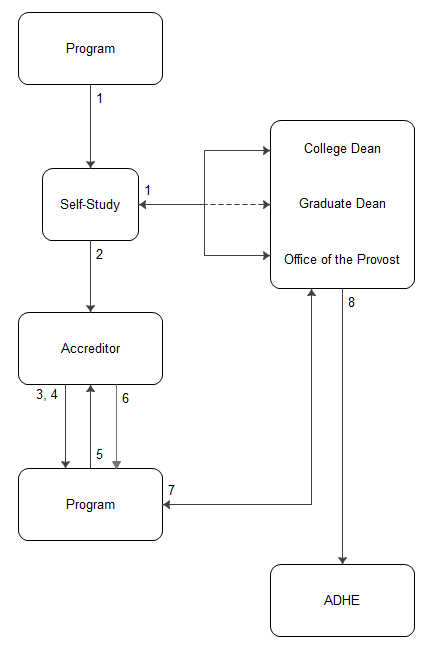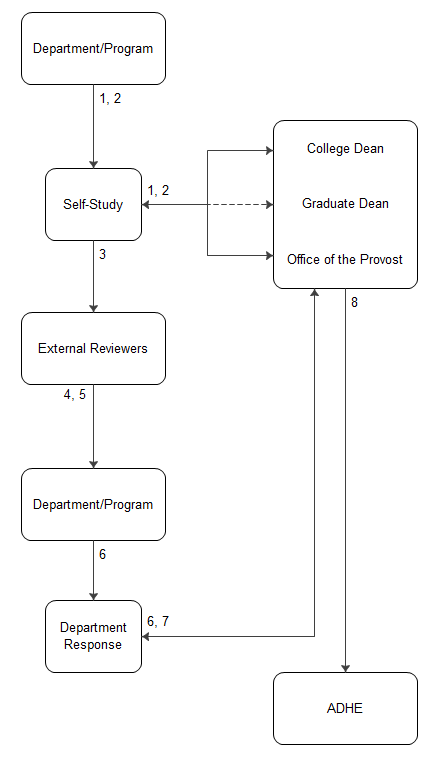[1] EAPR Process Milestones
Review of existing academic programs normally occurs during the fall or spring semester of the academic year in which the review is scheduled. This timing increases the chances that program faculty, staff, and students are available for the site visit. Any exception to this expectation must be approved by the Office of the Provost.
[1.1] The Year before Review
- February 1: Departments check the program review schedule (see EAPR Schedule) and begin the planning process for completing the review during the following academic year. If scheduling or other concerns arise, the department chair consults with the dean and the Office of the Provost to resolve the problems.
- March 15: Accredited programs communicate their accreditation review schedule to the Office of the Provost by this date or as soon as possible thereafter.
- April 15: Non-accredited programs, in consultation with their dean and the provost, select external consultants (see also Reviewers, Reviews, and Reporting Requirements), negotiate with them as necessary, determine a reasonable review schedule, and communicate the review plan to the Office of the Provost no later than April 15.
- As scheduled, the department completes a comprehensive self-study of the program (see Self-Study).
[1.2] The Year of Review
- The department concludes all internal reviews and approvals (see EAPR Communication Plan and Information Flow, below) and submits the self-study to the accreditor/reviewers.
- The department completes the review as scheduled, normally during the fall or spring semester.
[1.3] After Review
See also EAPR Communication Plan and Information Flow, below.
- The department receives a report from reviewers no later than six weeks after the review.
- In consultation with the dean, the department prepares a response to the reviewers’ findings. This response must be specific and include timelines and responsibilities when changes are to be made.
- The department ensures that the reviewers’ report and the departmental/college response are received by the Office of the Provost no later than four weeks after receipt of the reviewers’ report.
- The Office of the Provost submits to ADHE the reviewers’ report and the college/department response within six weeks of receipt by the department of the reviewers’ report.
[2] EAPR Process Communication Plans and Information Flow
[2.1] Accredited Programs
Accredited programs will be constrained by the usual review practices of and schedule imposed by their accreditors. With allowances for the particular practices of individual accreditors, the following list and Figure 1, below, detail the process.
- The program completes a comprehensive self-study and forwards copies of the self-study to the college dean and the Office of the Provost, allowing at least two weeks for the review and sufficient time to incorporate changes recommended on the basis of the review.
- The program sends the self-study to its accreditor and/or the visiting team of consultant/evaluators.
- As arranged with the accreditor, a site visit takes place.
- The site team’s written evaluation is sent to the department. The department forwards copies to the college dean and to the Office of the Provost.
- In consultation with the college dean, the program prepares a written response to the site team’s evaluation. The response is submitted as required by the accreditor, and a copy is forwarded to the Office of the Provost.
- The accreditor notifies the program (and others – typically the college dean and the university president) of its action. The department forwards a copy of the notification to the college dean, if necessary, and to the Office of the Provost.
- The Office of the Provost notifies other parties as appropriate and ensures disclosure of accreditation status in university publications.
- The Office of the Provost submits required documentation to ADHE within six weeks of receipt by the university of notification of the accreditor’s action.
[2.2] Non-Accredited Programs
In establishing a review schedule, non-accredited programs should consider the several steps to be completed during the review. The following list and Figure 2, below, detail the process.
- Program faculty, consulting with their college dean, prepare for the provost a list of five external professionals as potential consultants to the program, including information about professional qualifications/credentials of the potential reviewers.
The list of potential reviewers includes only professionals from programs outside the state of Arkansas with mission and scope similar to the program under review. To the best of its ability, program faculty determine that none of the potential reviewers has a conflict of interest that would preclude an unbiased review of the program.
The provost selects from this list two consultants for the review; the provost may request additional names from the program. Once the provost has selected the consultants, the faculty in the program determine which consultant will perform the on-site review and which will act as reader-consultant, subject to agreement by the college dean and the provost.
- The program completes a comprehensive self-study draft and forwards copies to the college dean, the graduate dean (if appropriate), and the Office of the Provost. The program allows at least two weeks for suggestions and comments from on-campus readers.
- The program sends the completed self-study and the EAPR Reviewers’ Report Template (linked here) to the two consultants selected in step 1 at least two weeks before the review is to take place or as arranged with the reviewers.
- As arranged with the on-site consultant, a site visit takes place. Typically, the program will have scheduled consultant interviews with the program’s students, faculty, and chair, the college dean, the graduate dean (if appropriate), and the provost.
- The two consultants confer, prepare a written evaluation of the program under review—using the EAPR Reviewers’ Report Template (linked here)—and send the evaluation to the program. The program immediately forwards copies to the college dean, the graduate dean (if appropriate), and the Office of the Provost.
- Within four weeks, the program prepares, in collaboration with the college dean, a written response to the consultants’ evaluation and forwards copies of the response to the graduate dean (if appropriate), and the Office of the Provost.
- The Office of the Provost notifies other parties as appropriate.
- The Office of the Provost submits required documentation to ADHE within six weeks of receipt by the university of the reviewers’ report.


